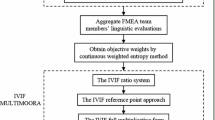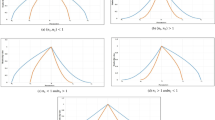Abstract
Failure mode and effect analysis (FMEA), a bottom-up method, is one of risk assessment tools to eliminate or reduce failures in design and process. It has been applied to many industries due to its flexibility and effectiveness. However, the conventional FMEA considers less about the subjectivity and vagueness in the process of risk assessment and assumes that three risk factors’ importance is the same. Although a lot of approaches based on fuzzy logic are proposed to deal with vague information in previous literature, they need priori assumptions leading to fixed intervals to express vagueness. In addition, most of the previous methods suppose that decision makers are totally rational without considering their psychological factors. To solve the problems, an extended technique for order performance by similarity to ideal solution (TOPSIS) is developed to improve FMEA approach, which combines the advantage of variable precision rough number in dealing with vague information and the strength of prospect theory (PT) in considering decision maker’s bounded rationality. The proposed method consists of two stages: one is the determination of risk factors’ weight function values; and the other is ranking risk priority of failure modes with the PT-based TOPSIS. Finally, a case study of a steam valve system is used to demonstrate the effectiveness and efficiency of the proposed method.




Similar content being viewed by others
Explore related subjects
Discover the latest articles, news and stories from top researchers in related subjects.References
Afshari H, Issa MH, Radwan A (2016) Using failure mode and effects analysis to evaluate barriers to the greening of existing buildings using the Leadership in Energy and Environmental Design rating system. J Clean Prod 127:195–203
Ahn J, Noh Y, Park SH, Choi BI, Chang D (2017) Fuzzy-based failure mode and effect analysis (FMEA) of a hybrid molten carbonate fuel cell (MCFC) and gas turbine system for marine propulsion. J Power Sources 364:226–233
Bao T, Xie X, Long P, Wei Z (2017) MADM method based on prospect theory and evidential reasoning approach with unknown attribute weights under intuitionistic fuzzy environment. Expert Syst Appl 88:305–317
Beaudouin F, Munier B (2009) A revision of industrial risk management: decisions and experimental tools in risk business. Risk Decis Anal 1(1):3–20
Braglia M, Frosolini M, Montanari R (2003) Fuzzy TOPSIS approach for failure mode, effects and criticality analysis. Qual Reliab Eng Int 19(5):425–443
Carmignani G (2009) An integrated structural framework to cost-based FMECA: the priority-cost FMECA. Reliab Eng Syst Saf 94(4):861–871
Carpitella S, Certa A, Izquierdo J, La Fata CM (2018) A combined multi-criteria approach to support FMECA analyses: a real-world case. Reliab Eng Syst Saf 169:394–402
Certa A, Hopps F, Inghilleri R, La Fata CM (2017) A Dempster–Shafer theory-based approach to the failure mode, effects and criticality analysis (FMECA) under epistemic uncertainty: application to the propulsion system of a fishing vessel. Reliab Eng Syst Saf 159:69–79
Chin KS, Wang YM, Poon GKK, Yang JB (2009) Failure mode and effects analysis by data envelopment analysis. Decis Support Syst 48(1):246–256
Fattahi R, Khalilzadeh M (2018) Risk evaluation using a novel hybrid method based on FMEA, extended MULTIMOORA, and AHP methods under fuzzy environment. Saf Sci 102:290–300
Franceschini F, Galetto M (2001) A new approach for evaluation of risk priorities of failure modes in FMEA. Int J Prod Res 39(13):2991–3002
Franceschini F, Rossetto S (1995) QFD: the problem of comparing technical/engineering design requirements. Res Eng Des 7(4):270–278
Gargama H, Chaturvedi SK (2011) Criticality assessment models for failure mode effects and criticality analysis using fuzzy logic. IEEE Trans Reliab 60(1):102–110
Huang J, Li ZS, Liu HC (2017) New approach for failure mode and effect analysis using linguistic distribution assessments and TODIM method. Reliab Eng Syst Saf 167:302–309
Jong CH, Tay KM, Lim CP (2013) Application of the fuzzy failure mode and effect analysis methodology to edible bird nest processing. Comput Electron Agric 96:90–108
Kahneman D, Tversky A (1979) Prospect theory: an analysis of decision under risk. Econometrica 47(2):263–292
Khoo LP, Zhai LY (2001) A prototype genetic algorithm-enhanced rough set-based rule induction system. Comput Ind 46(1):95–106
Lange K, Leggett S, Baker B (2001) Potential failure mode and effects analysis (FMEA) reference manual. Daimler Chrysler, Auburn Hills, Michigan, USA
Liu HC (2016) FMEA using uncertainty theories and MCDM methods. Springer, Singapore, pp 13–27
Liu HC, Liu L, Bian QH, Lin QL, Dong N, Xu PC (2011a) Failure mode and effects analysis using fuzzy evidential reasoning approach and grey theory. Expert Syst Appl 38(4):4403–4415
Liu P, Jin F, Zhang X, Su Y, Wang M (2011b) Research on the multi-attribute decision-making under risk with interval probability based on prospect theory and the uncertain linguistic variables. Knowl-Based Syst 24(4):554–561
Liu HC, Liu L, Liu N (2013) Risk evaluation approaches in failure mode and effects analysis: a literature review. Expert Syst Appl 40(2):828–838
Liu HC, Fan XJ, Li P, Chen YZ (2014) Evaluating the risk of failure modes with extended MULTIMOORA method under fuzzy environment. Eng Appl Artif Intel 34:168–177
Liu HC, Li Z, Song W, Su Q (2017) Failure mode and effect analysis using cloud model theory and PROMETHEE method. IEEE Trans Reliab 66(4):1058–1072
Liu HC, You JX, Shan MM, Su Q (2019) Systematic failure mode and effect analysis using a hybrid multiple criteria decision making approach. Total Qual Manag Bus Excell 30(5–6):537–564
Lourenzutti R, Krohling RA (2013) A study of TODIM in a intuitionistic fuzzy and random environment. Expert Syst Appl 40(16):6459–6468
Luo SH, Lee GG (2015) Applying failure mode and effects analysis for successful knowledge management. Total Qual Manag Bus Excell 26(1–2):62–75
Ozdemir Y, Gul M, Celik E (2017) Assessment of occupational hazards and associated risks in fuzzy environment: a case study of a university chemical laboratory. Hum Ecol Risk Assess Int J 23(4):895–924
Park GY, Kim DH, Lee DY (2014) Software FMEA analysis for safety-related application software. Ann Nucl Energy 70:96–102
Pawlak Z (1982) Rough sets. Int J Parallel Prog 11(5):341–356
Safari H, Faraji Z, Majidian S (2016) Identifying and evaluating enterprise architecture risks using FMEA and fuzzy VIKOR. J Intell Manuf 27(2):475–486
Seyed-Hosseini SM, Safaei N, Asgharpour MJ (2006) Reprioritization of failures in a system failure mode and effects analysis by decision making trial and evaluation laboratory technique. Reliab Eng Syst Saf 91(8):872–881
Simon HA (1971) Administrative behavior—a study of decision making processes in administrative organization. Macmillan Publishing Co, lnc, New York
Song W, Ming X, Wu Z, Zhu B (2013) Failure modes and effects analysis using integrated weight-based fuzzy TOPSIS. Int J Comput Integr Manuf 26(12):1172–1186
Song W, Ming X, Wu Z, Zhu B (2014) A rough TOPSIS approach for failure mode and effects analysis in uncertain environments. Qual Reliab Eng Int 30(4):473–486
Song W, Xu Z, Liu HC (2017) Developing sustainable supplier selection criteria for solar air-conditioner manufacturer: an integrated approach. Renew Sustain Energy Rev 79:1461–1471
Stamatis DH (2003) Failure mode and effect analysis: FMEA from theory to execution. ASQ Quality Press, Mexico
Tversky A, Kahneman D (1992) Advances in prospect theory: cumulative representation of uncertainty. J Risk Uncertain 5(4):297–323
von Ahsen A (2008) Cost-oriented failure mode and effects analysis. Int J Qual Reliab Manag 25(5):466–476
Zhai LY, Khoo LP, Zhong ZW (2010) Towards a QFD-based expert system: a novel extension to fuzzy QFD methodology using rough set theory. Expert Syst Appl 37(12):8888–8896
Zhang Z, Xu D, Ostrosi E, Yu L, Fan B (2019) A systematic decision making method for evaluating design alternatives of product service system based on variable precision rough set. J Intell Manuf 30(4):1895–1909
Zhou Q, Thai VV (2016) Fuzzy and grey theories in failure mode and effect analysis for tanker equipment failure prediction. Saf Sci 83:74–79
Funding
This study was funded by the National Natural Science Foundation of China (Grant Number 71971012, 71501006), Major Project of Social Science Foundation of Beijing (Grant Number 15ZDA49), and the Academic Excellence Foundation of BUAA for PhD Students.
Author information
Authors and Affiliations
Corresponding author
Ethics declarations
Conflict of interest
Hong Fang declares that she has no conflict of interest. Jing Li declares that she has no conflict of interest. Wenyan Song declares that he has no conflict of interest.
Ethical approval
This article does not contain any studies with human participants or animals performed by any of the authors.
Informed consent
Informed consent was obtained from all individual participants included in the study.
Additional information
Communicated by V. Loia.
Publisher's Note
Springer Nature remains neutral with regard to jurisdictional claims in published maps and institutional affiliations.
Rights and permissions
About this article
Cite this article
Fang, H., Li, J. & Song, W. Failure mode and effects analysis: an integrated approach based on rough set theory and prospect theory. Soft Comput 24, 6673–6685 (2020). https://doi.org/10.1007/s00500-019-04305-8
Published:
Issue Date:
DOI: https://doi.org/10.1007/s00500-019-04305-8




